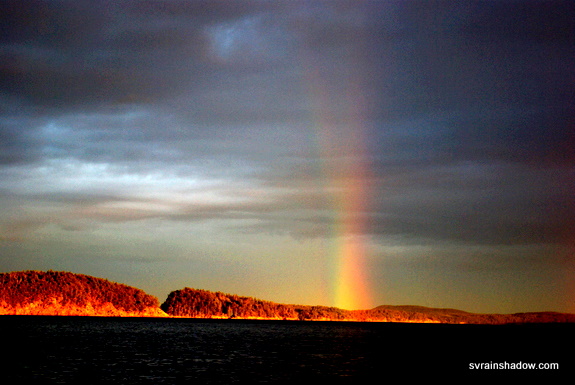A Double Double Rainbow

July 7th, 2010 | by Van | Published in Interesting
I’m sure most people have seen a double rainbow – in good conditions you can see both the primary rainbow (caused by diffraction of light exiting a raindrop after a single internal reflection) and a “secondary” rainbow, caused by diffraction of the light after two internal reflections. But have you seen a “double double rainbow”?
Jearl Walker was kind of a hero of mine when I was a budding teenage scientist back in the 70s and 80s in England. He wrote the Amateur Scientist column in Scientific American back then, and he had a nice article on Rainbows. Based on this article, I did a science project on rainbows in high school in England using lasers and drops of water suspended on small glass pipettes – with that setup you can see many higher order “rainbows” as well. I sent him a letter about a rainbow I’d seen that I thought was unusual, and he kindly wrote me back with an explanation. This was before the days of email…. But it left me with a fascination for rainbows.
Anyway, we were sailing in the San Juan Islands over the Memorial Day weekend this year (2010) and were were moored on a buoy at Spencer Spit. We were on the South side, even though the weather forecast was for a moderately strong blow from the South, so there was a chance we’d have to deal with a fair bit of chop overnight. However, we figured the blow would not arrive, and it was better than on the North side where you would have to deal with the wakes from passing ferries (we were right on both counts).
As the sun was setting, we were presented with a fabulous sunset and dramatic light and clouds all around. What caught my eye immediately, was the rainbow – it was double, but not in the usual sense of a primary and secondary bow. Instead, the primary rainbow was itself doubled! The photo above shows an enhanced picture of the scene – you can clearly see the rainbow rising from the land, and splitting in two directions.
What could this be?
To understand the answer, you need to understand that a rainbow is a circle of diffracted light that is centered about the point in the sky that is opposite the sun (called the anti-solar point). That’s why rainbows are always seen with your back to the sun, and also why the rainbow is never centered above the horizon. If it were, you’d see a ring of more than 180 degrees – but you never do.
The double primary in the photo is caused by the sun (creating the familiar primary on the left), and by the sun’s reflection in the sea to the West, creating a rainbow of its own. The seas were pretty calm, and were probably a good reflector for the sunlight. This new rainbow, like the common one, is centered in the sky opposite the apparent position of the sun. In this case, the apparent position (mirror image) of the sun is below the horizon, meaning the new rainbow is centered above the horizon! Very cool!
So why does that give a double primary rainbow? Well, the two circles have equal radii, and so they will meet on a line halfway between the two centers. Because the sun and its reflection are equally distant above and below the horizon, the reflected centers of the rainbows will be equally distant above and below the horizon. Thus, they will intersect along the horizon, and you will see a rainbow coming out of the ground, but spitting immediately in two.
So for the budding physicists out there, why does the photograph appear to show that the rainbows do not split exactly at the horizon as the explanation above would suggest??? If you look carefully, it would seem that the two rainbows cross a few degrees above the horizon! Please ping me with your ideas – I’m pretty sure I know the answer!